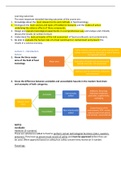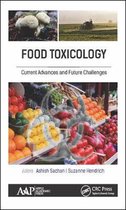Learning outcomes
The most important intended learning outcomes of the course are:
1. Knowledge about the most relevant terms and methods in food toxicology.
2. Distinguish the main sources and types of foodborne toxicants and the modes of action
underlying the adverse effects of these compounds.
3. Design and execute toxicological experiments in a comprehensive way and analyse and critically
discuss the results (in written format).
4. Understand the basic principles of the risk assessment of food constituents and contaminants.
5. Be able to evaluate the human risks of a food constituent or contaminant and present the
results in a concise oral way.
Define toxicity, mechanism of action and structure
Lecture 1 – Introduction activity relationships for chemicals to which humans
lecture are exposed via food.
1. Know the three major
aims of the field of food Major aims Evaluation of health and environmental
toxicology hazards and risks: risk assessment
Advisory task for authorities, industries
and consumers
2. Know the difference between avoidable and unavoidable hazards in the modern food chain
and examples of both categories.
Additives, flavorings,
Intentionally veterinary medicines,
Avoidable
added pesticides, supplements,
packaging
Modern food
chain
Contaminants of the
Non-intentionally environment, POP, metals,
Unavoidable
added natural toxins from plants
and animals, nanomaterials
NOTES
Avoidable
Additives (E-numbers):
These are substances added to food to perform certain technological functions (color, sweeten,
preserve). They have no proven track record of safety and must be approved before they can
be used. When approved based on safety/non safety concern they receive an E-number.
Flavorings:
,These are substances added to flavor food. They are not additives since is found in very low
levels. Except from sweeteners they do not have an E number. They must be approved before
being used according to the regulation EU 872/2012: there is an EU list of flavoring substances
which can be used in food.
Veterinary drugs:
Increased number of animals caused more disease and increased used of veterinary drugs.
Food supplements
Dietary supplements are considered food. Natural is not synonym of safe. This regulation varies
by country.
Unavoidable
POP: Persistent organic pollutants
Slow breakdown in environment and human body makes them very persistent. It accumulates
in the food chain. This type of pollutants includes:
Organochlorine pesticide (DDT): Organochlorine pesticides are chlorinated hydrocarbons used
extensively from the 1940s through the 1960s in agriculture and mosquito control.
DDT dichlorodiphenyltrichloroethane, also called 1,1,1-trichloro-2,2-bis(p-
chlorophenyl)ethane, a synthetic insecticide belonging to the family of
organic halogen compounds, highly toxic toward a wide variety of insects as a
contact poison that apparently exerts its effect by disorganizing the nervous system.
PCBs: PCBs belong to a broad family of man-made organic chemicals known as chlorinated
hydrocarbons. PCBs were domestically manufactured from 1929 until manufacturing was
banned in 1979. They have a range of toxicity and vary in consistency from thin, light-colored
liquids to yellow or black waxy solids.
Dioxins: Dioxins are mainly byproducts of industrial practices. They are produced through a
variety of incineration processes, including improper municipal waste incineration and burning
of trash, and can be released into the air during natural processes, such as forest fires and
volcanoes.
Brominated flame retardants (PBDEs, HBCDD): Brominated flame retardants (BFRs) are
organobromine compounds that have an inhibitory effect on combustion chemistry and tend to
reduce the flammability of products containing them. (Flame retardant)
The brominated variety of commercialized chemical flame retardants comprise approximately
19.7% of the market.
Heavy metals
Merury is toxic for born fish so it is not recommended to pregnant women.
,3. Understand why the topics of the Mercury
different lectures of the course are an
issue in food toxicology.
Apparently more residue problems are Arsenic
appearing due to increment of faster and
newer detection methods.
Lead
4. Knowledge of the 4 most important
metals in the field of food safety. Cadmium
Mercury, lead, cadmium and arsenic.
5. Knowledge of the different types of natural toxins in the modern food
chain.
• Mycotoxins (from fungi)
• Phytotoxins (from plants)
• Phycotoxins (from marine algae)
• Animal toxins
• Bacterial toxins
Especially 3 categories are of most concern in food chain
Nanomaterials: check
, 6. Understand why zero risk is no realistic option and why we need to define safe levels of
exposure and in some cases (some unavoidable chemicals) even acceptable risks.
In the market there are still products with avoidable additives that are still in research, and
unavoidable toxins in the environment. Thus zero risk is not realistic and to control the situation
safe levels of exposure shall be defined to protect the people. Also detection techniques are
improving over time and the safe level of exposure are continually updated.
7. Recognize the differences in perception between scientists and the general public on the food
related health risks.
Unbalances diet, microbial toxins, natural toxins, environmental contaminants, food additives
Lecture 1 - Introduction to online practical and lab safety
March 4th practical report
March 4th hand in presentation
One compound
Three assays: to assess different toxic mechanisms of a compound
Week 1:
Ames test: Genotoxicity?/Cause DNA damage?
Week 2:
Reporter Gene assay: Which receptor?/affect a specific cell signaling pathway?
Week 3:
EROD-assay: Phase I induction? (scientific article)/ Affect metabolism enzymes in the liver?
Dilutions
1. Weight using MW
2. Dissolve in DMSO
3. Make a diution series
4. Lowest-highest concentration
5. AMES, RG, EROD
AMES test





